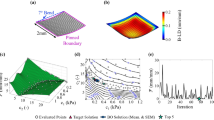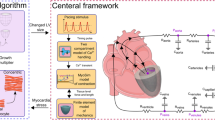Abstract
A mathematical model of the cardiomyocyte electromechanical function is used to study contribution of mechanical factors to rhythm disturbances in the case of the cardiomyocyte calcium overload. Particular attention is paid to the overload caused by diminished activity of the sodium-potassium pump. It is shown in the framework of the model, where mechano-calcium feedback is accounted for that myocardium mechanics may significantly enhance arrhythmogenicity of the calcium overload. Specifically, a role of cross-bridge attachment/detachment processes, a role of mechanical conditions of myocardium contractions (length, load), and a role of myocardium viscosity in the case of simulated calcium overload have been revealed. Underlying mechanisms are analyzed. Several approaches are designed in the model and compared to each other for recovery of the valid myocardium electrical and mechanical performance in the case of the partially suppressed sodium-potassium pump.
Similar content being viewed by others
References
Antzelevitch, C., Fish, J., 2001. Electrical heterogeneity within the ventricular wall. Basic Res. Cardiol. 96(6), 517–527.
Bers, D.M., 2002. Cardiac excitation-contraction coupling. Nature 415(6868), 198–205.
Charlemagne, D., et al., 1994. Alteration of Na,K-ATPase subunit mRNA and protein levels in hypertrophied rat heart. J. Biol. Chem. 269(2), 1541–1547.
DiFrancesco, D., Noble, D., 1985. A model of cardiac electrical activity incorporating ionic pumps and concentration changes. Philos. Trans. Roy. Soc. Lond. B Biol. Sci. 307(1133), 353–398.
Earm, Y.E., Noble, D., 1990. A model of the single atrial cell: relation between calcium current and calcium release. Proc. Roy. Soc. Lond. B Biol. Sci. 240(1297), 83–96.
Fuchs, F., Martyn, D., 2005. Length-dependent Ca(2+) activation in cardiac muscle: some remaining questions. J. Muscle Res. Cell Motil. 26(4–5), 199–212.
Gallagher, K.P., et al., 1986. The distribution of functional impairment across the lateral border of acutely ischemic myocardium. Circ. Res. 58(4), 570–583.
Gordon, A.M., et al., 2001. Skeletal and cardiac muscle contractile activation: tropomyosin “rocks and rolls”. News Physiol. Sci. 16, 49–55.
Hilgemann, D.W., Noble, D., 1987. Excitation-contraction coupling and extracellular calcium transients in rabbit atrium: reconstruction of basic cellular mechanisms. Proc. Roy. Soc. Lond. B Biol. Sci. 230(1259), 163–205.
Izakov, V., et al., 1991. Cooperative effects due to calcium binding by troponin and their consequences for contraction and relaxation of cardiac muscle under various conditions of mechanical loading. Circ. Res. 69(5), 1171–1184.
Katsnelson, L.B., Markhasin, V.S., 1996. Mathematical modeling of relations between the kinetics of free intracellular calcium and mechanical function of myocardium. J. Mol. Cell. Cardiol. 28(3), 475–486.
Katsnelson, L.B., et al., 2004. Influence of viscosity on myocardium mechanical activity: a mathematical model. J. Theor. Biol. 230(3), 385–405.
Katz, A.M., 2000. Physiology of the Heart, 3rd edn. Lippincott Williams & Wilkins, Philadelphia.
Kihara, Y., Morgan, J.P., 1991. Intracellular calcium and ventricular fibrillation. Studies in the aequorin-loaded isovolumic ferret heart. Circ. Res. 68(5), 1378–1389.
Lakatta, E.G., Guarnieri, T., 1993. Spontaneous myocardial calcium oscillations: are they linked to ventricular fibrillation? J. Cardiovasc. Electrophysiol. 4(4), 473–489.
Lew, W.Y., 1987. Influence of ischemic zone size on nonischemic area function in the canine left ventricle Am. J. Physiol. 252(5 Pt 2), H990–997.
Luo, C.H., Rudy, Y., 1994. A dynamic model of the cardiac ventricular action potential. II. Afterdepolarizations, triggered activity, and potentiation. Circ. Res. 74(6), 1097–1113.
Markhasin, V.S., et al., 2003. Mechano-electric interactions in heterogeneous myocardium: development of fundamental experimental and theoretical models. Prog. Biophys. Mol. Biol. 82(1–3), 207–220.
Moss, R.L., et al., 2004. Myosin crossbridge activation of cardiac thin filaments: implications for myocardial function in health and disease. Circ. Res. 94(10), 1290–1300.
Mulieri, L.A., Alpert, N.R., 1984. Differential effects of BDM on activation and contraction. Biophys. J. 45, 47.
Murray, J.M., Weber, A., 1981. Cooperativity of the calcium switch of regulated rabbit actomyosin system. Mol. Cell. Biochem. 35(1), 11–15.
Noble, D., 2002a. Modeling the heart–from genes to cells to the whole organ. Science 295(5560), 1678–1682.
Noble, D., 2002b. Modelling the heart: insights, failures and progress. Bioessays 24(12), 1155–1163.
Noble, D., Varghese, A., 1998. Modelling of sodium-overload arrhythmias and their suppression. Can. J. Cardiol. 14(1), 97–100.
Noble, D., et al., 1998. Improved guinea-pig ventricular cell model incorporating a diadic space, IKr and IKs, and length- and tension-dependent processes. Can. J. Cardiol. 14(1), 123–134.
Solovyova, O., et al., 2002. Mechanical inhomogeneity of myocardium studied in parallel and serial cardiac muscle duplexes: experiments and models. Chaos Solitons Fractals 13(8), 1685–1711.
Solovyova, O., et al., 2003. Mechanical interaction of heterogeneous cardiac muscle segments in silico: effects on Ca2+ handling and action potential. Int. J. Bifurcat. Chaos 13(12), 3757–3782.
Solovyova, O., et al., 2006. Activation sequence as a key factor in spatio-temporal optimization of myocardial function. Phil. Trans. Roy. Soc. Lond. A 364, 1367–1383.
Tennant, L.R., Wiggers, C.J., 1935. The effect of coronary occlusion on myocardial contraction. Am. J. Physiol. 112, H351–361.
Thandroyen, F.T., et al., 1991. Intracellular calcium transients and arrhythmia in isolated heart cells. Circ. Res. 69(3), 810–819.
Author information
Authors and Affiliations
Corresponding author
Rights and permissions
About this article
Cite this article
Sulman, T., Katsnelson, L.B., Solovyova, O. et al. Mathematical Modeling of Mechanically Modulated Rhythm Disturbances in Homogeneous and Heterogeneous Myocardium with Attenuated Activity of Na+–K+ Pump. Bull. Math. Biol. 70, 910–949 (2008). https://doi.org/10.1007/s11538-007-9285-y
Received:
Accepted:
Published:
Issue Date:
DOI: https://doi.org/10.1007/s11538-007-9285-y




